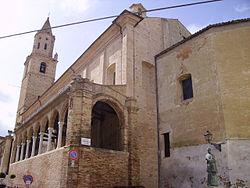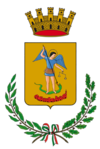Città Sant'Angelo
| Città Sant'Angelo | ||
|---|---|---|
| Comune | ||
| Comune di Città Sant'Angelo | ||
 |
||
|
||
| Location of Città Sant'Angelo in Italy | ||
| Coordinates: 42°31′N 14°03′E / 42.517°N 14.050°ECoordinates: 42°31′N 14°03′E / 42.517°N 14.050°E | ||
| Country | Italy | |
| Region | Abruzzo | |
| Province / Metropolitan city | Pescara (PE) | |
| Frazioni | Alzano, Annunziata, Crocifisso, Fagnano, Fonte Umano, Gaglierani, Maddalena, Madonna della Pace, Marina, Piano della Cona, Piano di Sacco, Ponticelli, San Giacomo, San Martino, San Pietro, San Rocco, San Vittorino, Sant'Agnese, Sorricchio, Vertonica, Villa Cipressi | |
| Government | ||
| • Mayor | Gabriele Florindi | |
| Area | ||
| • Total | 61 km2 (24 sq mi) | |
| Elevation | 322 m (1,056 ft) | |
| Population (30 September 2016) | ||
| • Total | 15,056 | |
| • Density | 250/km2 (640/sq mi) | |
| Demonym(s) | Angolani | |
| Time zone | CET (UTC+1) | |
| • Summer (DST) | CEST (UTC+2) | |
| Postal code | 65013 | |
| Dialing code | 085 | |
| Patron saint | Saint Michael the Archangel | |
| Website | Official website | |
Città Sant'Angelo (Italian: [tʃitˈta sanˈtandʒelo]) is a town and comune in the province of Pescara, Abruzzo, Italy. At the last census of 2015, the population was of 14,969 inhabitants. Its a member of I Borghi più belli d'Italia, an Italian association of towns of historical interest.
Located in the eastern portion of the Vestine region. Mentioned by Plinius as one of four Vestini cities, Angelus or Angulum, where today Città Sant'Angelo stands. It is cited from the 12th century as Castrum Sancti Angeli (Latin: "Castle of the Holy Angel").
It was a Guelph city destroyed in 1239 by Boemondo Pissono, executioner to Frederick II, Holy Roman Emperor of the Hohenstaufen dynasty, because the city was too loyal to his enemy, the Roman Catholic Church. Reconstruction began in 1240 and the city took the shape of a fortified nucleus in a semicircle. It gradually became one of several feudal possession, between the Carafa and the Piccolomini. The arrival of the monastic orders in the first half of the 14th century generated widening interest and finally a monastery was established. By 1528 it obtained the current name of the city. Gradually an agrarian bourgeoisie firmly established itself through to the 17th century.
At the turn of the 20th century, many people left the region and joined the mass migration to the Americas. Today, it is known for its historical architecture and as a tourist location that offers its own variety of wine and cuisine.
...
Wikipedia


